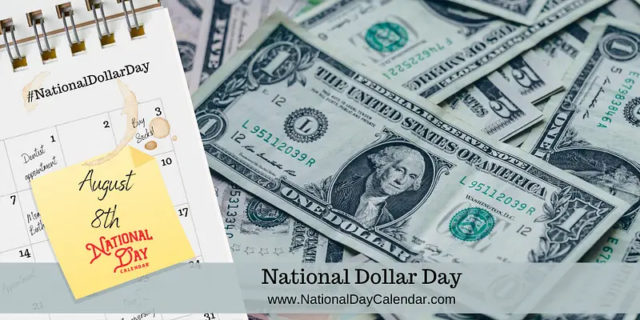
National Dollar Day on August 8th commemorates the day Congress established the U.S. monetary system in 1786.
- In 1862, the United States printed its first dollar bill. Do you know whose face was printed there? It wasn’t George Washington. The first dollar bill featured Salmon P. Chase, President Lincoln’s Secretary of Treasury.
- In 1862, the first USA paper money was printed. It was a solution for an issue, related to the shortage of coins.
- Interestingly, the dollar bill in our pockets today hasn’t been changed for more than 50 years. While the $5, $10, $20, and $50 earned redesigns in recent years, the single remains unchanged. Due to counterfeiting, redesigns keep the larger currencies ahead of counterfeiters.
- Above the right number 1 on the face side of the dollar, a tiny bird peeks out. Whether it’s an owl, an eagle or another such bird is uncertain. Like other embedded items in the bill’s design, it fuels many conspiracy theories.
- The first First Lady, Martha Washington, was one of the faces of the $1 silver certificate. First printed in 1886, the certificates were backed by the U.S. government’s silver deposits and featured an engraving of Martha based on her portrait by Charles Francois Jalabert. The silver certificates had a long run but were discontinued in 1957, though the last printing featuring Martha (this time with her husband) ran in 1896. To date, Martha Washington and Pocahontas are the only two women to have ever appeared on American paper currency.
- The George Washington portrait was first depicted on the $1 banknote in 1869.
- $1 bills represent 45% of entire currency production.
- If you need to trace a banknote by its serial number, then you should know that there is a site called “Where’s George?”, and it’s exactly what it does.
- A stack of dollar notes one mile high equals $14.5M
- The USA prints 37M notes daily, and it equals $696M
- About 90% of banknotes test positive for cocaine residue.
- A $1 bill has 13 arrows, 13 leaves, 13 stars, and 13 stripes, and it was a symbol of the original 13 colonies.
- The approximate lifespan of a $10 banknote is about 3.6 years, a $5 bill “lives” 3.8 years, a $1 note lasts 4.8 years, and a $100 bill can be in circulation for 18 years. However, the longevity of a coin is no less than 30 years
- $1M of $1 notes weighs almost as much as ’66 Volkswagen Beetle, while $1M of $20 banknotes weighs almost as much as a car tire.
- Andrew Jackson, the person on the $20 banknote, was a big confronter of paper money. He believed that only gold and silver coins were legal tender.
- Old dollar bills are shredded and sold to companies that recycle them into building materials.
- The Bureau of Engraving attempted a cheaper way of printing, called “web printing,” from 1992 to 1996. Although the agency stopped printing this way, the money is still legal tender and actually very valuable. These bills can be identified by a little number to the right of “Trust” in the motto. You can discover if you have one of these bills by seeing if they say either Series 1988A, Series 1993, or Series 1995.
- There are 12.4 billion dollar bills in circulation. According to the Federal Reserve’s latest calculations from 2019, there are a total of 43.4 billion bills circulating in the United States. That breaks down roughly as the following:
- 12.4 billion $1 bills
- 1.3 billion $2 bills
- 3.1 billion $5 bills
- 2.0 billion $10 bills
- 9.4 billion $20 bills
- 1.8 billion $50 bills
- 13.4 billion $100 bills
Sources:












